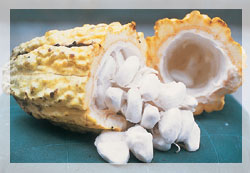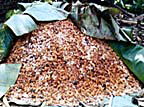

HOW CHOCOLATE IS MADE How cacao pods are made into chocolate
After picking, gatherers follow the harvesters who have removed the ripe pods from the trees. The pods are collected in baskets and transported to the edge of a field where the pod breaking operation begins. One or two lengthwise blows from a machete is usually enough to split open the woody shells. A good breaker can open 500 pods an hour.

A great deal of patience is required to complete harvesting. Anywhere from 20 to 50 cream-colored beans are scooped from a typical pod. The husk and inner membrane are discarded. Dried beans from an average pod weigh less than two ounces, and approximately 400 beans are required to make one pound of chocolate.
The beans are still many steps away from the familiar finished product. Exposure to air quickly changes the cream-colored beans to a lavender or purple. They do not look like the finished chocolate nor do they have the well-known fragrance of chocolate at this time.
The cocoa beans or seeds that are removed from the pods are put into boxes or thrown on heaps and covered. Around each bean is a layer of pulp that starts to heat up and ferment. Fermentation lasts from three to nine days and serves to remove the raw bitter taste of cocoa and to develop precursors and components that are characteristic of chocolate flavor.

A
mound of fermenting cacao beans
(Actually,
it's a compost pile and not a very good one. My
long
experience gardening tells me that a pile like this one,
high
moisture content and covered with banana leaves, would most
likely
be oxygen starved with the result that the core of the
pile
would putrefy. The smell would be horrendous unless
someone
turned it every day.)
Fermenting is a simple "yeasting" process in which the sugars contained in the beans are converted to acid, primarily lactic acid and acetic acid.
The process generates temperatures as high as 125 degrees Fahrenheit, which kill the germ of the bean and activate existing enzymes in the beans to form compounds that produce the chocolate flavor when the beans are roasted. The result is a fully developed bean with a rich brown color, a sign that the cocoa is now ready for drying.
Like any moisture-filled fruit, the beans must be dried if they are to keep. In some countries, drying is accomplished simply by laying the beans on trays or bamboo matting and leaving them to bask in the sun.

Fermented beans drying on a woven screen
When moist climate conditions interfere with sun-drying, artificial methods are used. For example, the beans can be carried indoors and dried by hot-air pipes.
With favorable weather the drying process usually takes several days. In this interval, farmers turn the beans frequently and use the opportunity to pick through them to remove foreign matter and flat, broken or germinated beans. During drying, beans lose nearly all their moisture and more than half their weight.
When the beans are dried, they are prepared for shipping in 130 to 200 pound sacks. They are seldom stored except at shipping centers, where they await inspection by buyers.
Buyers sample the quality of a crop by cutting open a number of beans to see that they are properly fermented. Purple centers indicate incomplete fermentation.
If the prevailing crop is found satisfactory, the grower is paid at the current market price. The market price depends not only on the abundance of the worldwide crop and the quality of farmers' crops in a number of countries, but on a number of economic conditions throughout the world. The industry has set up Cocoa Exchanges, similar to stock exchanges, in principle cities such as New York, London, Hamburg and Amsterdam.
We now come to the remarkable art of chocolate making, a process that is comparable with the skill and finesse of the world's greatest chefs. The manufacturing process requires much time and painstaking care. Just to make an individual-size chocolate bar, for instance, takes from two to four days.
Manufacturing methods will differ in detail from plant to plant, but there is a general processing pattern which prevails everywhere. It is this pattern that makes the chocolate industry distinctive from every other industry.
For example, all manufacturers carefully catalogue each shipment according to its particular type and origin. This is very important, because it enables them later to maintain exact control over the flavor blending of beans for roasting.
While awaiting the blending process, the beans are carefully stored. The storage area must be isolated from the rest of the building so the sensitive cocoa does not come into contact with strong odors, which it may absorb as an off-flavor. Every step of the way so far reflects the close regulation of conditions which is needed to ensure the production of uniformly high quality chocolate.
The first step to actual manufacturing is cleaning. This is done by passing the cocoa beans through a cleaning machine that removes dried cacao pulp, pieces of pod and other extraneous material that had not been removed earlier.
When thoroughly cleaned, the beans are carefully weighed and blended according to a company's particular specifications. These formulas are based on experience and desirability. In the science of chocolate making, much depends upon the ability to achieve the right formula for the desired end product through the proper selection of the beans that are available.
To bring out the characteristic chocolate aroma, the beans are roasted in large rotary cylinders. Depending upon the variety of the beans and the desired end result, the roasting lasts from 30 minutes to two hours at temperatures of 250 degrees Fahrenheit and higher. As the beans turn over and over, their moisture content drops, their color changes to a rich brown, and the characteristic aroma of chocolate becomes evident.
Proper roasting is one of the keys to good flavor. After roasting, the beans are quickly cooled and their thin shells, made brittle by roasting, are removed. In most factories, this is done by a "cracker and fanner," a giant winnowing machine that passes the beans between serrated cones so they are cracked rather than crushed. In the process, a series of mechanical sieves separate the broken pieces into large and small grains while fans blow away the thin, light shell from the meat or "nibs."
The nibs, which contain about 53 percent cocoa butter, are next conveyed to mills, where they are crushed between large grinding stones or heavy steel discs. The process generates enough frictional heat to liquefy the cocoa butter and form what is commercially know as chocolate liquor. The term liquor does not refer to alcohol, it simply means liquid. When the liquid is poured into molds and allowed to solidify, the resulting cakes are unsweetened or bitter chocolate.
Up to this point, the manufacturing of cocoa and chocolate is identical. The process now diverges, but there is an important interconnection to be noted. The by-product of cocoa shortly becomes an essential component of chocolate. That component is the unique vegetable fat, cocoa butter, which forms about 25 percent of the weight of most chocolate bars.
The chocolate liquor, destined to become a cup of cocoa, is pumped into giant hydraulic presses weighing up to 25 tons, where pressure is applied to remove the desired cocoa butter. The fat drains away through metallic screens as a yellow liquid. It is then collected for use in chocolate manufacturing.
Cocoa butter has such importance for the chocolate industry that it deserves more than a passing mention. It is unique among vegetable fats because it is a solid at normal room temperature and melts at 89 to 93 degrees Fahrenheit, which is just below body temperature. It resists oxidation and rancidity, making possible to be stored for years without spoiling.
The pressed cake that is left after the removal of cocoa butter can be cooled, pulverized and sifted into cocoa powder. Cocoa that is packaged for sale to grocery stores or put into bulk for use as a flavor by dairies, bakeries, and confectionery manufacturers, may have 10 percent or more cocoa butter content. "Breakfast cocoa," a less common type, must contain at least 22 percent cocoa butter.
In the so-called "Dutch" process, the manufacturer treats the cocoa with an alkali to develop a slightly different flavor and give the cocoa a darker appearance characteristic of the Dutch type. The alkali acts as a processing agent rather than as a flavor ingredient.
While cocoa is made by removing some of the cocoa butter, eating chocolate is made by adding it. This holds true of all eating chocolate, whether it is dark, bittersweet, or milk chocolate. Besides enhancing the flavor, the added cocoa butter serves to make the chocolate more fluid.
One example of eating chocolate is sweet chocolate, a combination of unsweetened chocolate, sugar, cocoa butter and perhaps a little vanilla. Making it entails melting and combining the ingredients in a large mixing machine until the mass has the consistency of dough.
Milk chocolate, the most common form of eating chocolate, goes through essentially the same mixing process-except that it involves using less unsweetened chocolate and adding milk.
Whatever ingredients are used, the mixture then travels through a series of heavy rollers set one atop the other. Under the grinding that takes place here, the mixture is refined to a smooth paste ready for "conching."
Conching is a flavor development process which puts the chocolate through a "kneading" action and takes its name from the shell-like shape of the containers originally employed. The "conches," as the machines are called, are equipped with heavy rollers that plow back and forth through the chocolate mass anywhere from a few hours to several days. Under regulated speeds, these rollers can produce different degrees of agitation and aeration in developing and modifying the chocolate flavors.
Conching effects the flavor by driving off harsh, volatile chemicals and improves texture by rounding off the edges of the cocoa and sugar particles, much like a rock tumbler.
In some manufacturing setups, there is an emulsifying operation that either takes the place of conching or else supplements it. This operation is carried out by a machine that works like an eggbeater to break up sugar crystals and other particles in the chocolate mixture to give it a fine, velvety smoothness.
After the emulsifying or conching machines, the mixture goes through a tempering process then at last into molds to be formed into the shape of the completed product. The molds take a variety of shapes and sizes, from the popular individual-size bars available to consumers to a ten-pound block used by confectionery manufacturers.
When the molded chocolate reaches the cooling chamber, cooling proceeds at a fixed rate that keeps the flavor intact. The bars are then removed from the molds and passed along to wrapping machines to be packed for shipment to distributors, confectioners and others throughout the country.
(Source: www.karachocolates.com)
Return to main page
for more chocolate pages or browse 70 other topics: everything from
Knitting Nancies and metal detectors to the strange world of lucid dreaming.